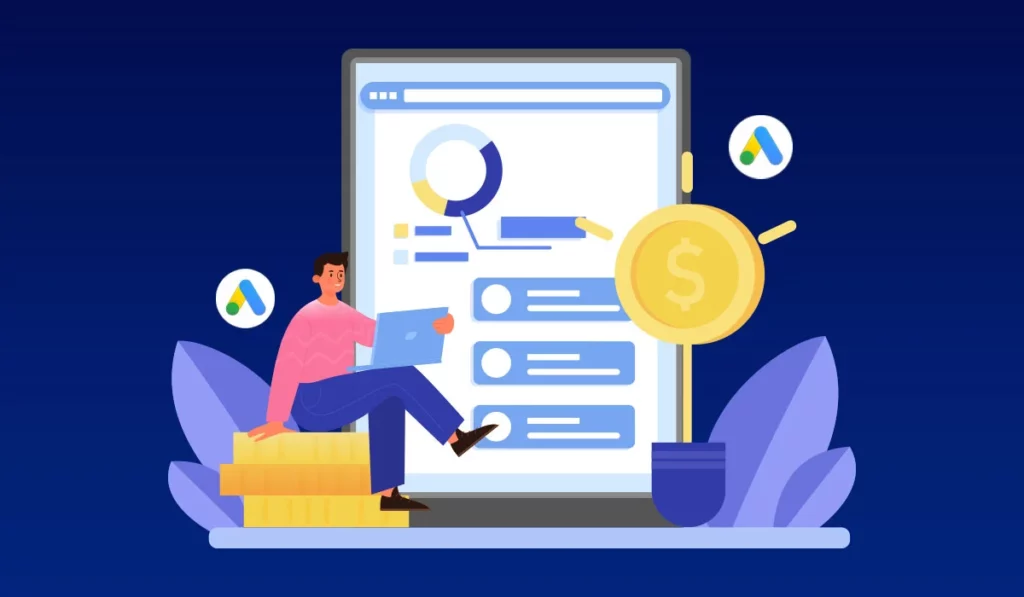Optimizing Your Google Ads Budget
Vineetha. RK17 Jul 2024
Google Ads is an effective online advertising platform for reaching out to potential customers.
It offers different tools and features to optimize your campaigns for maximum impact.
One of the most important aspects of running a successful Google Ads campaign is effectively managing your budget.
Without proper budget optimization in Google Ads, even the most well-crafted ads can fail to deliver the desired results.
So in this blog, let’s explore the intricacies of Google Ads budget optimization, providing you with best practices and strategies to make sure that your advertising dollars are well-spent.
By understanding the relevance of optimizing your Google Ads Budget, you can significantly improve your campaign performance and ROI.

What’s Ahead
- What Is Google Ads Budget Optimization?
- How Do Google Ads Campaign Budgets Work?
- Best Practices for Google Ads Budget Optimization
- Conclusion
What Is Google Ads Budget Optimization?
Google Ads budget optimization is strategically managing and allocating your advertising budget to maximize the effectiveness and efficiency of your campaigns.
This makes sure that every dollar spent contributes to achieving your marketing objectives, such as driving traffic, generating leads, and increasing sales.
By optimizing your Google Ads budget, you can avoid overspending on failed ads and focus your resources on the most profitable opportunities.
This involves a continuous process of monitoring and adjusting your bids, targeting, and ad placements to improve the return on investment (ROI) of your campaigns.
How Do Google Ads Campaign Budgets Work?
To effectively optimize your Google Ads budget, it is essential to get an understanding of how campaign budgets function.
Google offers flexible options to help advertisers control their spending while maximizing their campaign’s potential.
Let’s take a look at the key concepts related to the working of Google Ads Campaign Budget.
Budget pacing
Budget pacing is the practice of spreading your budget evenly over a specified period.
It helps to ensure that your budget lasts for the entire campaign duration.
This prevents your budget from being exhausted too quickly and helps maintain a steady flow of ad impressions and clicks.
This is crucial for maintaining a consistent presence in the ad auction and for reaching your target audience throughout your campaign’s duration.
There are two types of budget pacing:
Standard delivery that aims to spread your budget evenly throughout the day.
Accelerated delivery that spends your budget more quickly, potentially exhausting it before the day ends.
-
Automatic Pacing
Google Ads employs automated pacing to automatically adjust your daily spend based on the performance and opportunities available on any given day.
For instance, if there is higher traffic and more potential for conversions on a particular day, Google may slightly increase your spending to capitalize on these opportunities.
However, it also ensures that your overall monthly spending aligns with your budget.
-
Preventing Early Exhaustion
Without budget pacing, your campaign might spend its entire budget too quickly, leaving you without ad coverage for the remainder of the period.
By pacing your budget, Google Ads helps maintain a continuous flow of ad impressions and clicks, which is especially important for long-term campaigns.
Daily spending limit
The daily spending limit is the maximum amount you are willing to spend on your Google Ads campaigns each day.
This limit is set by you and helps control the daily expenditure, ensuring you don’t overspend daily.
-
Setting Daily Budgets
When you create a campaign, you specify a daily budget that fits within your overall marketing budget.
Google uses this daily limit as a guideline to manage how much you spend each day.
-
Daily Spend Variations
While you set a daily budget, Google Ads may spend up to twice this amount on days when there is a higher potential for conversions or better ad opportunities.
This is known as overdelivery.
However, over the course of a month, the average daily spend will align with your set daily budget.
For example, if you are setting a daily budget of $50, Google Ads might spend up to $100 on a high-traffic day.
However, this over-delivery is balanced out by spending less on other days, ensuring your monthly budget is not exceeded.
Monthly spending limit
The monthly spending limit is calculated to ensure that your overall spending stays within your set budget for the month despite daily fluctuations.
This provides security against excessive spending and helps maintain financial control.
-
Calculation Method
Google Ads calculates the monthly spending limit by multiplying your daily budget by the average number of days in a month (30.4).
For example, if your daily budget is $50, your monthly spending limit would be $50 x 30.4 = $1,520.
-
Ensuring Consistency
This method offers flexibility in daily spending while ensuring that your total monthly expenditure remains consistent with your planned budget.
It allows for changes in daily traffic and ad performance, making it easier to manage longer campaigns.
-
Monitoring and Adjustments
Google Ads provides tools and reports to help you monitor your spending against the monthly limit.
If you notice that your spending is not rising to your expectations, you can adjust your daily budgets or pause unsuccessful campaigns to stay within your budget.
Best Practices for Google Ads Budget Optimization
Now that you have understood the basics, let’s explore some best practices for Optimizing Your Google Ads Budget:
Select Keywords Strategically
The foundation of any successful Google Ads campaign is a well-researched keyword strategy.
Using the right keywords guarantees that your ads appear in relevant search results, attracting potential clients who are more likely to convert.
When optimizing your Google Ads Budget, focus on:
-
Keyword Research
Make use of tools like Google Keyword Planner to identify keywords with high search volume and low competition.
This helps you find cost-effective keywords that can drive quality traffic to your website.
-
Long-Tail Keywords
Include long-tail keywords in your ad strategy.
These keywords are more specific and often less competitive, leading to higher conversion rates and lower cost-per-click (CPC).
-
Negative Keywords
You can use negative keywords to filter out irrelevant traffic that can drain your advertising budget and decrease the effectiveness of your campaigns.
This prevents your ads from showing up in searches that are not relevant to your business, saving budget and improving the quality of your leads.
-
Search intent
Always make sure that your keywords align naturally with user intent to improve conversion rates
Enhance Quality Score for Better Performance
Quality Score is a metric to assess the relevance and quality of your ads, keywords, and landing pages.
It is a crucial factor used by Google in determining your ad rank and Cost per click.
A higher Quality Score can lead to lower costs and better ad placements, effectively expanding your budget further.
Improve your Quality Score by:
-
Ad Relevance
Always ensure that your ad copy is closely aligned with the keywords you are targeting.
This increases the likelihood of users clicking on your ad, improving your click-through rate (CTR) and Quality Score.
-
Landing Page Experience
You can optimize your landing pages for relevance and user experience.
The landing page should provide valuable content that matches the user’s search intent, be easy to navigate, and load quickly.
-
Click-Through Rate (CTR) Improvement
Focus on writing compelling ad copy that encourages and motivates users to click on your ads.
Include clear and persuasive calls to action (CTAs) and highlight unique selling points (USPs) to stand out from competitors.
Use Google Ads’ Location Targeting Feature
Location targeting helps you to show your advertisements to users in specific geographic areas.
It ensures that your budget is spent on audiences that are most likely to convert into loyal customers.
You can improve your location targeting by:
-
Define Target Areas
Identify the regions where your potential customers are located.
This could be specific countries, states, cities, or even a radius around a particular location.
-
Adjust Bids by Location
Use bid adjustments to increase or decrease your bids based on the performance of different locations.
This helps allocate more budget to high-performing areas while reducing spend on low-performing ones.
-
Local Ad Customization
Customize your ad copy to resonate with local audiences.
Mentioning local landmarks, events, or regional preferences can make your ads more appealing and relevant.
If you’re running multiple campaigns with similar goals, you can consider using Google Ads’ shared budgets feature.
It allows you to allocate a single budget across multiple campaigns, ensuring efficient use of your resources.
The benefits of using Google Ads Shared Budget are:
-
Automatic Allocation
Google Ads automatically distributes your shared budget across all campaigns, directing funds to where they are needed most.
This prevents any single campaign from underperforming due to a lack of budget.
-
Simplified Management
Managing multiple campaigns with a shared budget simplifies budget adjustments and tracking.
You can easily see how your overall budget is being utilized and make necessary changes without spending more time managing each campaign.
-
Flexible Allocation
Shared budgets offer flexibility, allowing you to quickly reallocate funds based on changing campaign performance or market conditions.
Utilize Bid Simulator for Informed Decisions
The Bid Simulator tool provides valuable insights into how changes in your bids might impact your campaign performance.
It helps you make data-driven decisions for optimizing your Google Ads Budget.
You can use Bid Simulator for:
-
Forecasting Performance
You can use this tool to estimate how different bid amounts could affect your clicks, impressions, and costs.
This helps you understand the potential impact of bid adjustments before implementing them.
-
Optimal Bidding
With this tool, you can identify the bid levels that offer the best balance between cost and performance.
This ensures you are not overpaying for clicks while maintaining a competitive position in the ad auction.
-
Competitive Analysis
Bid Simulator can give you insights into how your bids compare to those of your competitors.
This can help you adjust your strategy to stay competitive without overspending.
Analyzing Your Google Campaign Budget
Regular analysis of your campaign performance is essential for ongoing Google Ads Budget optimization.
Use Google Ads’ reporting tools to track the key metrics and identify areas for improvement.
Here are some aspects that you need to focus on:
-
Performance Metrics
Always monitor important metrics such as CTR, conversion rate, cost per acquisition (CPA), and return on ad spend (ROAS).
These indicators help you assess the effectiveness of your campaigns and make informed decisions.
-
Budget Allocation
Make sure to analyze how your budget is being spent across different campaigns, ad groups, and keywords.
Identify the underperforming areas of the ads and reallocate the budget to higher-performing ones.
-
Trend Analysis
Always look for trends and patterns in your campaign data.
Seasonal fluctuations or shifts, changes in user behavior, or market trends can all impact your campaign performance.
You can adjust your strategy accordingly to capitalize on these insights.
Conclusion
Optimizing Your Google Ads Budget is an ongoing process that requires attention to detail, strategic thinking, and a willingness to adapt based on performance data.
By understanding how Google Ads budgets work and adopting the best practices for Google Ads Budget Optimization, you can improve the effectiveness of your advertising campaigns.
Continuously analyze your campaign performance to identify opportunities for improvement and make data-driven decisions to optimize your Google Ads budget.
Regular analysis and adjustments can ensure that your budget is always working towards achieving your marketing goals.
A successful budget optimization is not about spending less but it is about spending smarter!
Wish to learn more about Google ads? Check out our other blogs as well!
- Understanding Different Types of Google Ads
- How to Write Compelling Ad Copy for Google Ads
- Tracking Conversions in Google Ads
- Common Google Ads Mistakes to Avoid
- How to Create Effective Display Ads on Google Ads
- Remarketing with Google Ads: Strategies to Win Back Customers
- Smart Bidding Strategies in Google Ads: What You Need to Know
- The Ultimate Guide to Google Ads Extensions
- Ultimate Guide to Google Ads
- How to Set Up a Successful Google Ads Campaign
Latest Post

5 Do’s and Don’ts When It Comes To SEO
 18 Sep 2023
Readmore
18 Sep 2023
Readmore
Want to learn more about the digital marketing service we provide?
Contact Us to Get Started!




